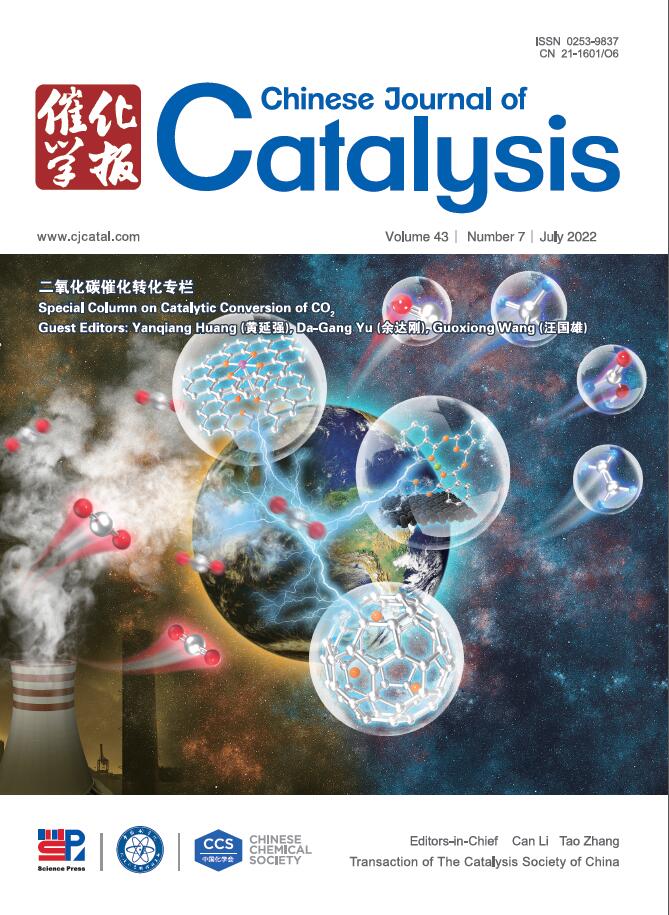一种稳定的酰基钴基催化剂,具有异常高的环氧化物羰基化成β-内酯的活性
IF 15.7
1区 化学
Q1 CHEMISTRY, APPLIED
引用次数: 0
摘要
摘要聚羟基烷酸酯(PHA)是一种以β-内酯为单体的生物可降解聚合物,它可以在定义明确的[Lewis酸]+[Co(Co)4] -催化剂下,通过环氧化合物的扩环羰基化反应选择性地合成。然而,在超过80°C的温度下,[Co(Co)4] -物种的分解为在高温反应条件下开发商业上可行的工艺以减少反应时间带来了障碍。借鉴历史上HCo(Co)4催化氢甲酰化过程中稳定的{(酰基)Co(Co)n}中间体的见解,我们寻求环氧化物环扩张羰基化的高温催化活性。所开发的催化剂体系[(乙酰基)Co(Co)2dppp]和[(TPP)CrCl]表现出优异的催化性能,在100℃下的初始周转频率为4700 h-1,周转次数为93000。值得注意的是,该催化剂表现出了出色的稳定性,在80°C下运行168 h,选择性地生成β-内酯。本文章由计算机程序翻译,如有差异,请以英文原文为准。
A stable acyl cobalt-based catalyst with exceptionally elevated activity for the carbonylation of epoxides into β-lactones
ABSTRACT
Polyhydroxyalkanoate (PHA), a well-known biodegradable polymer, features β-lactones as its monomers, which can be selectively synthesized through ring-expansion carbonylation of epoxides using well-defined [Lewis acid]+[Co(CO)4]– catalysts. However, the decomposition of [Co(CO)4]– species at temperatures exceeding 80 °C presents a hurdle for the development of commercially viable processes under high-temperature reaction conditions to reduce reaction time. Drawing insights from stable {(acyl)Co(CO)n} intermediates involved in historical HCo(CO)4-catalyzed hydroformylation processes, we sought to the high-temperature catalytic activity of epoxide ring-expansion carbonylation. The developed catalyst system, [(acetyl)Co(CO)2dppp] and [(TPP)CrCl], exhibited exceptional catalytic performance with an unprecedented initial turnover frequency of 4700 h–1 at 100 °C and a turnover numbers of 93000. Notably, the catalyst displayed outstanding stability, operating at 80 °C for 168 h while selectively generating β-lactones.
求助全文
通过发布文献求助,成功后即可免费获取论文全文。
去求助
来源期刊

Chinese Journal of Catalysis
工程技术-工程:化工
CiteScore
25.80
自引率
10.30%
发文量
235
审稿时长
1.2 months
期刊介绍:
The journal covers a broad scope, encompassing new trends in catalysis for applications in energy production, environmental protection, and the preparation of materials, petroleum chemicals, and fine chemicals. It explores the scientific foundation for preparing and activating catalysts of commercial interest, emphasizing representative models.The focus includes spectroscopic methods for structural characterization, especially in situ techniques, as well as new theoretical methods with practical impact in catalysis and catalytic reactions.The journal delves into the relationship between homogeneous and heterogeneous catalysis and includes theoretical studies on the structure and reactivity of catalysts.Additionally, contributions on photocatalysis, biocatalysis, surface science, and catalysis-related chemical kinetics are welcomed.
 求助内容:
求助内容: 应助结果提醒方式:
应助结果提醒方式:


